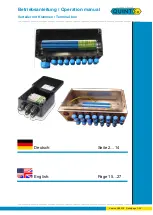
Figure 4.9
Access Point Setting
14. Assign a network name, SSID; the given network name should already be typed in.
15. Check if the wireless mode is used as
Ad Hoc
mode. The 802.11 standard supports
two network topologies:
Ad Hoc
and
Infrastructure
mode. A standalone Ad Hoc
network topology consists of at least two wireless stations without using access
points. This type of network is often referred to as Peer-to-Peer network because it
can be constructed quickly without much planning overhead. Ad Hoc mode LANs
are normally less expensive because they do not require a dedicated computer to
store applications and data. However, they do not perform well for large networks.
16. Check the ‘
Data Encryption’
box if the network requires
WEP
service enabled.
Wired Equivalent Privacy
is a security mechanism defined within the 802.11
standard designed to make the link integrity of the wireless medium equal to wired
cable. Data privacy mechanism based on a 40 bits (128 bit optional) shared key
algorithm, as described in the IEEE 802.11 standard.
17. Check the ‘
Network Authentication’
box if the network requires it to be in Shared
Mode. In
Open System
, the default authentication service that simply announces
the desire to associate with another station or access point. A station can
authenticate with any other station or access point using open system authentication
if the receiving station designates open system authentication. In
Share Key
, The
optional authentication that involves a more rigorous exchange of frames, ensuring
that the requesting station is authentic. For a station to use shared key
authentication, it must implement WEP.
18. Check the
‘The key is provided automatically’
box if the network provides the key
automatically. Otherwise, leave the box unchecked and click
Modify WEP Key
to
supply all the necessary information on the screen, and then click
OK
.
















































